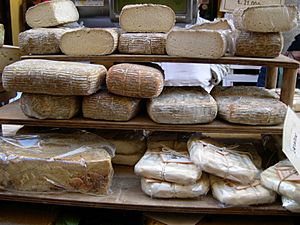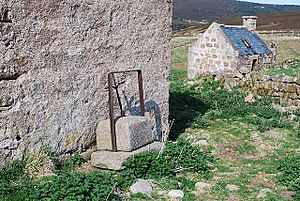History of cheese facts for kids
| This article contains special characters. Without proper rendering support, you may see question marks, boxes, or other symbols. |
Imagine a world without cheese! It's hard to picture, right? Cheese has been a part of human history for a very, very long time. In fact, people were making cheese over 7,000 years ago, even before writing was invented!
Scientists think cheese was discovered by accident. Early humans used to store and carry milk in bags made from the stomachs of animals like cows or sheep. These animal stomachs naturally contain something called rennet, which makes milk curdle and turn into solid curds. This happy accident likely led to the first cheeses. We don't know for sure where cheese-making started, but it could have been in Europe, Central Asia, the Middle East, or even the Sahara Desert.
Contents
When Was Cheese First Made?
No one knows the exact moment cheese was invented. But we have found some amazing clues! The oldest direct evidence of cheese-making comes from clay sieves (pottery with holes) that are over 7,000 years old. These have been found in places like Kujawy, Poland, and the Dalmatian coast in Croatia. In Croatia, scientists even found dried remains that chemical tests suggest were cheese!
Even older pottery shards, possibly used as cheese strainers, were found in Switzerland, dating back about 8,000 years ago.
Early cheese was probably made by pressing and salting curdled milk to help it last longer. Storing milk in animal stomachs, which contain rennet, would have made solid curds. This likely led people to intentionally add rennet to milk to make cheese.
Cheese in Hot and Cold Climates
Hard, salty cheese was probably made from the very beginning of dairying (raising animals for milk). This is because in hot places, it's the only way to keep milk from spoiling. Dairying was happening in the Sahara Desert around 4,000 BC.
In cooler places like Europe, cheese didn't need as much salt to be preserved. With less salt and acidity, cheese became a good home for helpful microbes and molds. These tiny living things give aged cheeses their strong and interesting flavors.
Early Written Records of Cheese
The first written records of cheese come from ancient Sumerian texts around 2000 BC. These early cheeses were likely sour and salty, similar to cottage cheese or feta today. Later, in ancient Greece, tablets from the Minoan-Mycenaean culture listed cheese as part of their inventory, along with flocks of sheep and shepherds.
An old Arab story says that cheese was discovered by an Arab trader who stored milk in an animal stomach. However, cheese was already well known by the Sumerians long before that.
Cheese in Ancient Egypt, Greece, and Rome
Archaeologists have found evidence of cheese-making in ancient Egypt dating back about 5,000 years. In 2018, scientists found the oldest known cheese from Egypt in a tomb. It was about 3,200 years old! Even earlier, cheese remains were found in an Egyptian tomb from around 2900 BC. Pictures of Egyptians making cheese were also found in tomb paintings from about 2000 BC.
The ancient Greeks knew about cheese-making too. In Greek mythology, the god Aristaeus is credited with discovering cheese. The famous Greek poet Homer wrote about the Cyclops making and storing sheep's and goat's milk cheese in his epic poem, Odyssey, around the 8th century BC:
We soon reached his cave, but he was out shepherding, so we went inside and took stock of all that we could see. His cheese-racks were loaded with cheeses, and he had more lambs and kids than his pens could hold...
When he had so done he sat down and milked his ewes and goats, all in due course, and then let each of them have her own young. He curdled half the milk and set it aside in wicker strainers.
By Roman times, cheese-making was very common. The Romans loved cheese and even imported special cheeses from other places to enjoy. Roman writers like Columella and Pliny the Elder wrote about how cheese was made and the many different kinds of cheeses Romans ate.
Cheese in Europe After the Roman Empire
Most of the cheeses we know today were first recorded in the late Middle Ages. For example, Cheddar has been around since the 1100s, Parmesan was first made in 1597, Gouda in 1697, and Camembert in 1791.
As the Roman Empire declined, different parts of Europe developed their own unique cheese-making traditions. Local bacteria and methods helped create a huge variety of cheeses. Monasteries (places where monks lived) were often known for making special cheeses.
Today, countries like Britain, France, Italy, and Spain have hundreds of different types of cheeses, many of which are protected by law to ensure their quality and origin.
In 1546, a saying claimed "the moon is made of a greene cheese" (meaning new or unaged cheese). This funny idea has been repeated for centuries, and even NASA used it for an April Fools' Day joke in 2006!
Cheese in the Americas and Asia
When Europeans first came to the Americas, explorers reported that the Inca people in the Andes mountains ate llama cheese. However, some studies haven't found clear evidence of milking llamas in these cultures.
Since Europeans settled in the Americas, many local cheeses have been developed across both North and South America. While mass-produced cheese became very popular, recently, more people in the US have started making special farmstead (or farmhouse) and artisan cheeses by hand.
In Asia, preserved cheese from 1615 BC was found in the Taklamakan Desert in Xinjiang, China. Today, local cheese like paneer is common in South Asia. In China, while dairy isn't a main part of the culture, some regions like Yunnan have strong cheese traditions, including cheeses similar to paneer. There are also many different kinds of Tibetan cheeses.
Modern Cheese Production
Until modern times, cheese was mostly found in Europe, the Middle East, and North Africa. It was much less common in other parts of the world. But as European culture spread, so did the popularity of cheese.
How Cheese is Mass-Produced Today
The first factory for making cheese opened in Switzerland in 1815. But large-scale cheese production really took off in the United States. A dairy farmer named Jesse Williams from Rome, New York, started making cheese in an assembly-line way using milk from nearby farms in 1851. Soon, hundreds of dairy companies were doing the same.
Around the 1860s, mass-produced rennet became available. By the early 1900s, scientists learned how to grow pure cultures of the tiny microbes that help make cheese. Before this, the bacteria in cheese came from the environment or from reusing leftover whey. Using pure cultures meant that factories could make standardized cheese that tasted the same every time.
Mass production made cheese much more affordable for everyone. Simple ways to store cheese at home became popular, like ceramic cheese dishes or "cheese bells," which helped keep cheese fresh until refrigerators became common in homes around 1913.
During World War II, factory-made cheese became even more popular than traditional, handmade cheese. Today, most cheese in America and Europe comes from factories. In America, people even buy more processed cheese (like cheese slices) than "real" factory-made cheese.



